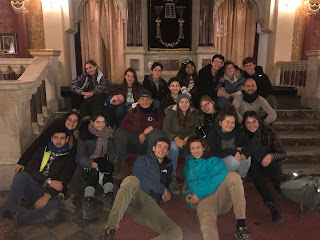On March 14th, our class traveled to Kochav HaYarden and then to the mystic city of Tzfat. When we first arrived at Kochav HaYarden we were greeted with an incredible view of the Jordan Valley, an area where 500,000 birds migrate through to Africa each year (cool fact David!)

We then jumped back in history to the year 638, when Islam took control of Israel. Different empires of Islam, also called caliphates, ruled various territories in Israel. Back in Europe, Christianity was spreading rapidly. Pope Urban II and many other Christians felt that it was their duty to spread the teachings of Jesus Christ to the rest of the world. This was one of the popular reasons given for starting the Crusades. Pope Urban II additionally spread mass propaganda about the Muslims, claiming they are evil, subhuman, animals who needed to be “dealt with.” In truth, the reason behind the Crusades was most likely the fact that the Europe was overpopulated, sick, starving, and dying. The Crusades were an amazing opportunity for the peasants that had nothing to lose; they had food to eat, an income, and a guaranteed spot in heaven for doing Gods work. The first Crusade began in 1096, and in 1099 the Crusaders arrived in Jerusalem to retake the Church of the Holy Sepulchre and overthrow the Muslim rule. The Belvoir Fortress that we visited was built in 1168 by the Crusaders, although a Muslim by the name of Salahadin retook it 18 years later. This was quite a great feat considering the extensive defenses of the fort, like secret entrances/exits, high walls, and its hilltop location.


Anti-Semitic feelings spread rapidly once the Christians siezed the various territories of Israel from the Muslims. Jews were accused of blood libel, drinking the blood of Christian children, poisoning the wells, witchcraft, and desecration of the host.
We then traveled to Tzfat, where we began by visiting the Rabbi Yosef Karo Synagogue, which has a 500 year old Torah and a Ganiza full of ancient books. Many Safardic Jews settled in Tzfat after the Spanish Inquisition, and the Yosef Karo Synogogue is a beautiful Safardic style building.
Yosef Karo was born in 1488 in Spain and was one of the Jews who moved to Safed, where he wrote the Shulchan Aruch or “set table.” This book was a comprehensive guide to following Halacha, which Karo believed would bring the Messiah if the rules were followed exactly. His book set the interpretations and rules of the Talmud in place, from now on interpreting the Talmud in a different way would be much more difficult.
Next came Rabbi Shimen Bar Yochai, one of the authors of the Zohar. He had the some of first ideas about Jewish mysticism- a slightly magical and transcendent side of Judaism that goes beyond the physical world. The reason Tzfat is the last of the four holy cities of Israel is because of mysticism. He also believed that the hardships that Jews went through were simply “growing pains of the Messiah” or things that the Jews had to struggle through in order to bring the Messianic era. Another Rabbi credited with the first ideas of mysticism is Rabbi Moshe Codovera, who invented the Ten Spheres of Sefirot. These spheres each had mystic ideas, which Codovera believed could lead to a true understanding and connection with God. Lastly we talked about Rabbi Yitzhak Luria, who took combined the ideas of Halacha and Mysticism in order to “pull down the Messiah.”
Mysticism or Kabbalah bring an other worldly aspect into Judaism, and by my understanding focuses less on religion and more on spirituality. My question is: where do your religious beliefs meet your spiritual ones? Are they intertwined, the same, or separate? Does spirituality have a place in Judaism, or is it so personal that it can’t be mixed with religion? If you don’t feel comfortable answering this question, alternatively: Can things that are considered spiritual such as meditation and yoga be a part of Judaism?











































